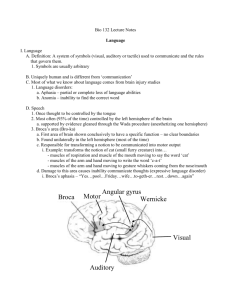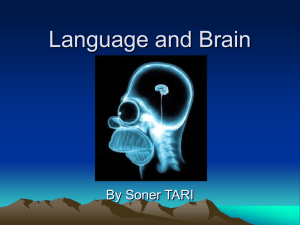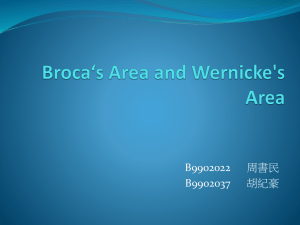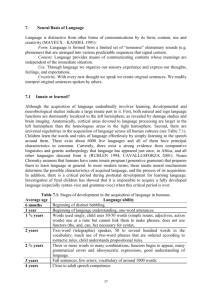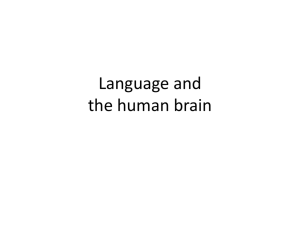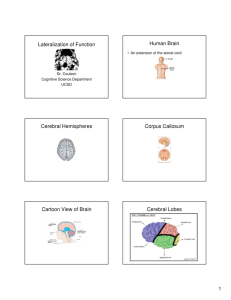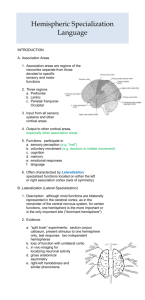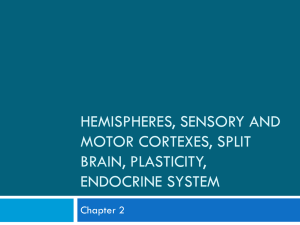Language and Brain - UCSD Cognitive Science
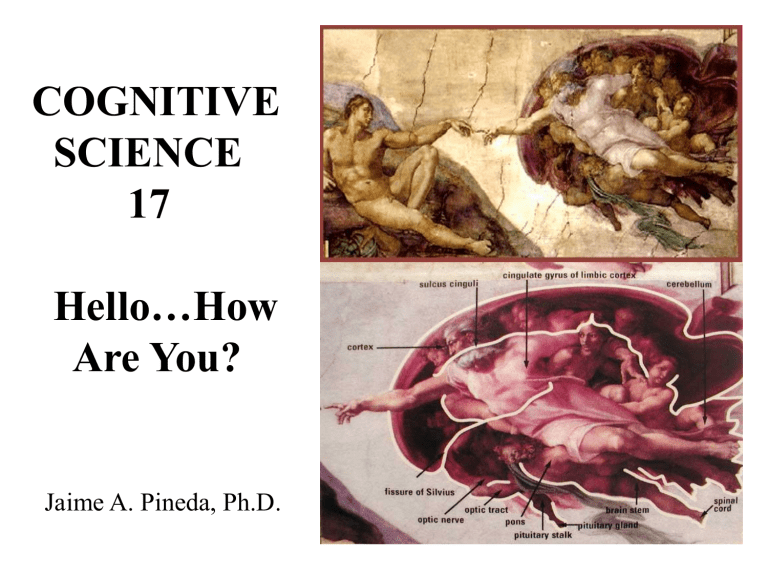
COGNITIVE
SCIENCE
17
Hello…How
Are You?
Jaime A. Pineda, Ph.D.
Communication
• Different forms
– Verbal (speech)
– Sign (gestures)
– Writing (symbols)
• Important social behaviors
• Have made cultural evolution possible
• Enabled discoveries to be cumulative
– Knowledge passed from generation to generation
Language Acquisition
• Modularity (Chomsky, 1959)
– Is there a language “mental organ”? Or does it arise from more primitive functions?
• Is it unique to humans?
– What causes the difference?
– Evolution of Language:
• Gestures were important
• Language and thought
– Are they interrelated?
• Universal grammar?
Birdsong
• Similar to human languages in sensitive period
• Stages of development:
– Initial exposure to the song of tutor (father)
– Successive approximation of produced song to the stored model
– Crystalization of the song in permanent form
• Deafening and distorting studies by Konishi
• Brain damage studies confirm vocal control centers view
• neurogenesis
Nonhuman Primates
• Vocalizations look preprogramed, serving specific purposes only
• Initiated by sub-cortical areas like limbic system
• But for vocalization and decoding, they also use left hemisphere
• Unique cases
– Kanzi
– Washoe (ASL)
– Sarah (tokens)
What is Language?
• Grammar
– Phonetics, morphology, syntax, semantics
• Symbol usage
• Ability to represent real-world situations
• Ability to articulate something new
• Intention to communicate
• Duality, productivity, arbitrariness, interchangeability, specialization, displacement, and cultural transmission (Linden 1974)
“An infinitely open system of communication”
Rumbaugh, 1977
Language & Cognition
Why language is important
Only species to use language with syntactic and productive properties.
The dog bit the man.
The man bit the dog.
Syntax: rules governing legal word order. We have implicit knowledge of syntax.
Colourless green ideas sleep furiously.
Sentence meaning depends on word meaning & word order.
Language and Cognition
Why language is important
Language comprehension is rapid and automatic.
Involves integration of word meaning, syntax, context & knowledge.
Take roughly 250 msec to read individual words.
State color of ink used for following words:
RED
GREEN
BLUE
GREEN
RED
BLUE
Stroop task
Language & Cognition
Why language is important
Language production is rapid.
Involves overlapping stages of planning
message, selecting
words and structure, sequencing
production of component sounds and controlling articulation. [Levelt, 1987]
Dialog is rapid and highly interactive.
Suggests interactive sequence of
comprehension, cognition & production.
Teaching Language to Apes
• Why teach language to apes?
• Throughout the history, all efforts to teach speech to animals have failed
• ASL was taught to chimpanzees to some extent
• Lana Project at Emory
University:
– Try to teach Yerkish to chimps (computerized symbols)
– Chimps are able to form novel and meaningful chains
Teaching Language to Apes
Why [try to teach apes language]? What is there to suggest we would listen to anything an ape could tell us? Or that he would be able to tell us of his life in a language that hasn't been born of that life?... Maybe it is not that they have yet to gain a language, it is that we have lost one
(Adams & Carwardine 1993)
Deep Down and Internal
Representation
• Savage-Rumbaugh believes that
– Language ability of chimps is underestimated
– Chimps can understand speech (but can’t produce)
– Language comprehension comes before speech for several million years
– Intention to communicate is important
• Pinker says “they just don’t get it…”
Language Disorders
• Egyptians reported speech loss after blow to head 3000 years ago
• Broca (1861) finds damage to left inferior frontal region (Broca’s area) of a language impaired patient, in postmortem analysis
Language Disorders
• In language disorders
– 90-95% of cases, damage is to the left hemisphere
– 5-10% of cases, to the right hemisphere
• Wada test is used to determine the hemispheric dominance
– Sodium amytal is injected to the carotid artery
– First to the left and then to the right
Brain areas involved in Language
Lateralization of the Brain
• LH more specialized for the analysis of sequences of stimuli that occur quickly but sequentially (comprehension and production).
• RH more specialized for the analysis of space and geometrical shapes and forms that occur simultaneously.
– Involved in organizing a narrative
(selecting and assembling the elements of what we want to say)
– understanding prosody (rhythm and stress)
– recognizing emotion in the tone of voice
– Understanding jokes
Lateralization of functions
• Left-hemisphere:
– Sequential analysis
• Analytical
• Problem solving
– Language
• Right-hemisphere:
– Simultaneous analysis
• Synthetic
– Visual-Spatial skills
• Cognitive maps
• Personal space
• Facial recognition
• Drawing
– Emotional functions
• Recognizing emotions
• Expressing emotions
– Music
Language Disorders
• Paraphasia :
– Substitution of a word by a sound, an incorrect word (“treen” instead of “train”)
• Neologism :
– Paraphasia with a completely novel word
(colloquialism or slang)
• Nonfluent speech :
– Talking with considerable effort
• Agraphia :
– Impairment in writing
• Alexia :
– Disturbances in reading
Three major types of Aphasia
• Broca’s aphasia
– Slow, laborious, nonfluent speech
• Wernicke’s aphasia
– Fluent speech but unintelligible
• Global aphasia
– Total loss of language
Others: Conduction, Subcortical, Transcortical
Motor/Sensory
Broca’s Aphasia
Brodmann 44, 45
• Lesions in the left inferior frontal region (Broca’s area), head of caudate nucleus, thalamus, etc.
• Nonfluent, labored, and hesitant speech ( articulation )
• Most also lose the ability to name persons or subjects ( anomia )
• Can utter automatic or overlearned speech (“hello”; songs)
• Have difficulty with function (the, in, about) vs content words
(verbs, nouns, adjectives) ( agrammatism )
• Comprehension relatively intact when other cues available (The man swat the mosquito vs the horse kicks the cow)
• Most also have partial paralysis of one side of the body
(hemiplegia)
• If extensive, not much recovery over time
Broca’s Aphasia
• Broca’s area contains “memories of the sequences of muscular movements
(tongue, lips, jaw, etc) that are needed to articulate words”
Wernicke (1874)
• But also more than just this…
Wernicke’s Aphasia
Brodmann 22, 30
• Lesions in posterior part of the left superior temporal gyrus, extending to adjacent parietal cortex
• Unable to understand what they read or hear (poor comprehension)
• Unaware of their deficit
• Fluent but meaningless speech
• Can use function but not content words
• Contains many paraphasias
– “girl”-“curl”, “bread”-“cake”
• Syntactical but empty sentences
• Cannot repeat words or sentences
• Usually no partial paralysis
Wernicke-Geschwind Model
1. Repeating a spoken word
• Arcuate fasciculus is the bridge from the Wernicke’s area to the Broca’s area
Wernicke-Geschwind Model
2. Repeating a written word
• Angular gyrus is the gateway from visual cortex to Wernicke’s area
• This is an oversimplification of the issue:
– not all patients show such predicted behavior (
Howard, 1997)
Sign Languages
• Full-fledged languages, created by hearingimpaired people ( not by Linguists):
– Dialects, jokes, poems, etc.
– Do not resemble the spoken language of the same area (ASL resembles Bantu, Navaho, and
Japanese more than English)
– Pinker: Nicaraguan Sign Language
– Another evidence of the origins of language
(gestures)
• Most gestures in ASL are with right-hand, or else both hands (left hemisphere dominance)
• Signers with brain damage to similar regions show aphasia as well
Signer Aphasia
• Young man, both spoken and sign language:
– Accident and damage to brain
– Both spoken and sign languages are affected
• Deaf-mute person, sign language:
– Stroke and damage to left-side of the brain
– Impairment in sign language
• 3 deaf signers:
– Different damages to the brain with different impairments to grammar and word production
Spoken and Sign Languages
• Neural mechanisms are similar
• fMRI studies show similar activations for both hearing and deaf
• But in signers, homologous activation on the right hemisphere is unanswered yet
Dyslexia
• Problem in learning to read
• Common in boys and left-handed
• High IQ, so related with language only
• Postmortem observation revealed anomalies in the arrangement of cortical cells
– Micropolygyria: excessive cortical folding
– Ectopias: nests of extra cells in unusual location
• Might have occurred in midgestation, during cell migration period
Acquired Dyslexia = Alexia
• Disorder in adulthood as a result of disease or injury
• Deep dyslexia (pays attn. to wholes):
– “cow” -> “horse”, cannot read abstract words
– Fails to see small differences (do not read each letter)
– Problems with nonsense words
• Surface dyslexia (pays attn. to details):
– Nonsense words are fine
• Suggests 2 different systems:
– One focused on the meanings of whole words
– The other on the sounds of words
Electrical Stimulation
• Penfield and Roberts (1959): During epilepsy surgery under local anesthesia to locate cortical language areas, stimulation of:
– Large anterior zone:
• stops speech
– Both anterior and posterior temporoparietal cortex:
• misnaming, impaired imitation of words
– Broca’s area:
• unable comprehend auditory and visual semantic material,
• inability to follow oral commands, point to objects, and understand written questions
Studies by Ojemann et al.
• Stimulation of the brain of an English-Spanish bilingual shows different areas for each language
• Stim of inferior premotor frontal cortex:
– Arrests speech, impairs all facial movements
• Stim of areas in inferior, frontal, temporal, parietal cortex:
– Impairs sequential facial movements, phoneme identification
• Stim of other areas:
– lead to memory errors and reading errors
• Stim of thalamus during verbal input:
– increased accuracy of subsequent recall
PET by Posner and Raichle
• Passive hearing of words activates:
– Temporal lobes
• Repeating words activates:
– Both motor cortices, the supplemental motor cortex, portion of cerebellum, insular cortex
• While reading and repeating:
– No activation in Broca’s area
• But if semantic association:
– All language areas including
Broca’s area
• Native speaker of Italian and
English:
– Slightly different regions
PET by Damasios
• Different areas of left hemisphere (other than
Broca’s and Wernicke’s regions) are used to name (1) tools, (2) animals, and (3) persons
• Stroke studies support this claim
• Three different regions in temporal lobe are used
• ERP studies support that word meaning are on temporal lobe (may originate from
Wernicke’s area):
– “the man started the car engine and stepped on the pancake”
– Takes longer to process if grammar is involved
Williams Syndrome
• Caused by the deletion of a dozen genes from one of the two chromosomes numbered
7
• Shows dissociation between language and intelligence, patients are:
– Fluent in language
– But cannot tie their shoe laces, draw images, etc.
• Developmental process is altered:
– Number skills good at infancy, poor at adulthood
– Language skills poor at infancy, greatly improved in adulthood
– Guest speaker in the colloquium, Annette
Karmiloff-Smith, claims the otherwise:
• Development alters the end result of the syndrome (?)
Split-brain
• Epileptic activity spread from one hemisphere to the other thru corpus callosum
• Since 1930, such epileptic treated by severing the interhemispheric pathways
• At first no detectible changes (e.g. IQ)
• Animal research revealed deficits:
– Cat with both corpus callosum and optic chiasm severed
– Left-hemisphere could be trained for symbol:reward
– Right-hemisphere could be trained for inverted symbol:reward
Left vs. Right Brain
• Pre and post operation studies showed that:
– Selective stimulation of the right and left hemisphere was possible by stimulating different parts of the body (e.g. right/left hand):
• Thus can test the capabilities of each hemisphere
– Left hemisphere could read and verbally communicate
– Right hemisphere had small linguistic capacity: recognize single words
– Vocabulary and grammar capabilities of right is far less than left
– Only the processes taking place in the left hemisphere could be described verbally
Normal Cortical Connections
Language
Dominant Side
Broca’s
Area
Motor
Cortex
Callosal
Connections
Motor
Cortex
What changes if the corpus callosum is damaged?
The Split Brain Studies
Language
Dominant Side
Broca’s
Area
Motor
Cortex
Motor
Cortex
How about the
Bunny?
The Split Brain Studies
Language
Dominant Side
Broca’s
Area
Motor
Cortex
Motor
Cortex
The left hand can point to it, but you can’t describe it!
Other studies
• Right ear advantage in dicothic listening:
– Due to interhemispheric crossing
• Words in left-hemisphere, Music in right
– Supported by damage and imaging studies
– But perfect-pitch is still on the left
• Asymmetry in planum temporale:
– Musicians with perfect-pitch has 2x larger PT
– Evident in newborns, thus suggesting innate basis for cerebral specialization for language and speech
Finally
• Precision of stimulus analysis in the brain is reduced on the midline areas of the body
• Speech organs (vocal tract, tongue, larynx, etc.) are in the midline
• Asymmetry of motor control of speech areas
(sidedness in language) provides unchallenged control
– Observed in songbirds too
• But hemispheric dominance is not absolute, both sides are necessary:
– After commisurotomy, left is better than right, but both are affected

